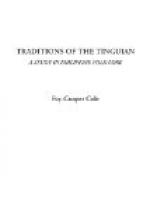[19] A sacred dance in which a number of men and women take part. It takes place only at night and is accompanied by the singing of the participants.
[20] The night preceding the greatest day of the Sayang ceremony.
[21] Runo, a reed.
[22] See p. 11, note 3.
[23] A short ceremony held for the cure of fever and minor ills. It also forms a part of the more extensive rites.
[24] A sugar-cane rum.
[25] See p. 10, note 1.
[26] Lesser spirits.
[27] Like ideas occur in the folktales of British North Borneo. See Evans, Journal Royal Anthro. Inst., Vol. XLIII, 1913, p. 444.
[28] In various guises the same conception is found in Europe, Asia, Africa, and Malaysia. See Cox, An Introduction to Folklore, p. 121 (London, 1904).—In an Igorot tale the owner captures and marries the star maiden, who is stealing his rice. Seidenadel, The Language of the Bontoc Igorot, p. 491 ff. (Chicago, 1909).
[29] The Dusun of Borneo have tales of talking jars. Evans, Journal Royal Anthro. Inst., Vol. XLIII, 1913, pp. 426-427. See also Cole and Laufer, Chinese Pottery in the Philippines (Pub. Field Museum of Nat. Hist., Vol. XII, No. 1, p. 11 ff., 1912).
[30] Piper sp.
[31] Bagobo tales relate that in the beginning plants, animals, and rocks could talk with mortals. See Benedict, Journal American Folklore, Vol. XXVI, 1913, p. 21.
[32] Tales of animals who assist mortals are found in all lands; perhaps the best known to European readers is that of the ants which sorted the grain for Cinderella. See also Evans, Jour. Royal Anthro. Inst., Vol. XLIII, 1913, p. 467, for Borneo; Tawney’s Katha Sarit Sagara, pp. 361 ff., Calcutta, 1880, for India.
[33] Fabulous birds of gigantic size, often known under the Indian term garuda, play an important part in the beliefs of the Peninsular Malays.
[34] A similiar incident is cited by Bezemer (Volksdichtung aus Indonesien). See also the Bagobo tale of the Kingfisher (Benedict, Jour. American Folklore, Vol. XXVI, 1913, p. 53).
[35] The magic flight has been encountered in the most widely separated parts of the globe, as, for instance, India and America. See Tawney, Katha Sarit Sagara, pp. 361, 367 ff. and notes, (Calcutta, 1880); Waterman, Jour. American Folklore, Vol. XXVII, 1914, p. 46; Reinhold Koehler, Kleinere Schriften, Vol. I, pp. 171, 388.
[36] In the Dayak legend of Limbang, a tree springs from the head of a dead giant; its flowers turn to beads; its leaves to cloth; the ripe fruit to jars. See H. Ling Roth, The Natives of Sarawak and British North Borneo, Vol. I, p. 372.




